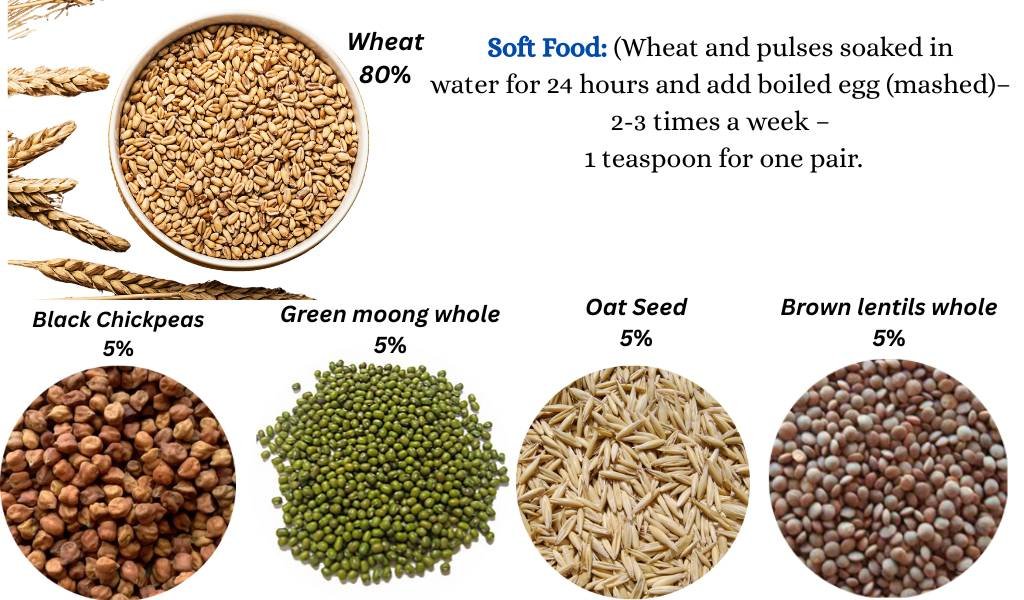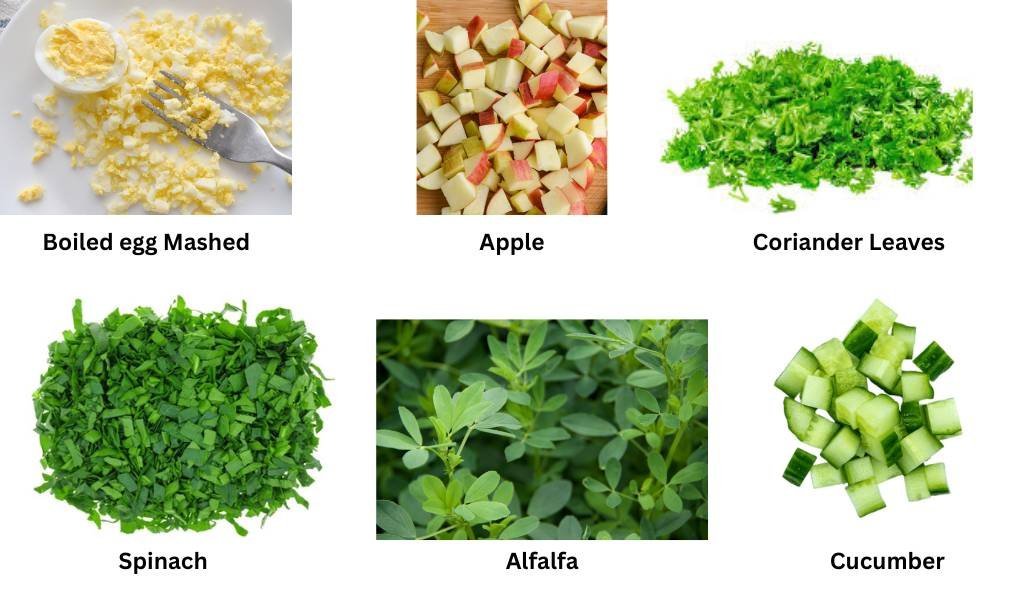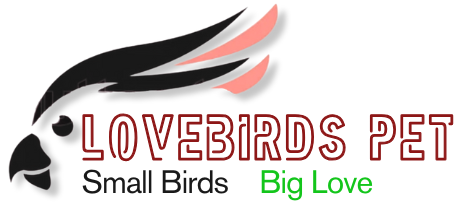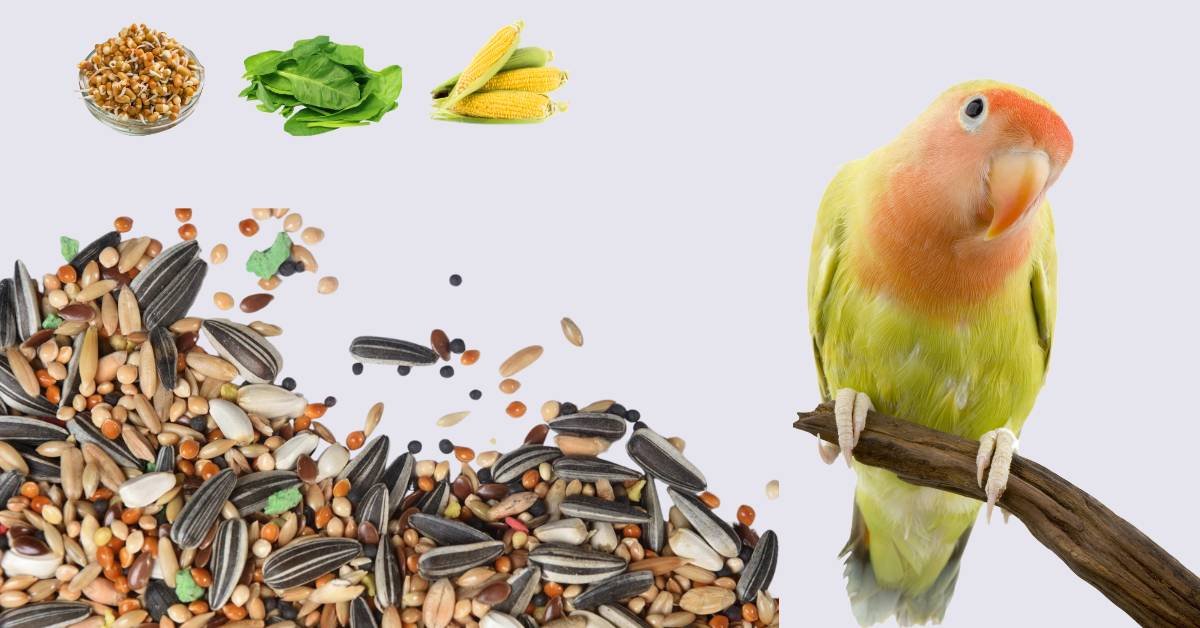Tahir Ilyas – Aviculturist and Lovebird Breeding Specialist Since 2008
When breeding lovebirds, providing the correct food is the primary responsibility of the pet owner. Throughout the years, I have realised that good nutrition is not simply about keeping your birds alive, but about helping them thrive. Whether you have them as pets or for breeding, you’ll learn everything you need to know about what lovebirds should eat to be healthy, active, and have a shiny, lustrous coat in this complete guide.
Understanding the Natural Diet of Lovebirds

In the wild, lovebirds eat seeds, grasses, fruits, and vegetation. They’ll eat bark, insects, and grains when other food is not available. This diversity is natural and helps the bees stay healthy and become resistant to disease.
To replicate a natural diet at home:
- Feed a variety of seeds, grains, fresh fruits, and vegetables.
- Add natural foraging options, such as leafy vegetables and millet sprigs.
- Food rotation helps reduce the risk of nutritional deficiencies.
Balanced Diet Chart for Lovebirds
A good diet for lovebirds should include the following five key components:
| Pellets | 30% – 40% | Formulated pellets designed specifically for parrots and lovebirds | Delivers complete, balanced nutrition in every bite. Prevents selective eating. |
| Seeds | 20% – 30% | Sunflower (in moderation), flaxseed (linseed), white millet, canary seed | High in healthy fats and proteins. Provides natural energy. Best when not overfed. |
| Fresh Vegetables | 15% – 20% | Spinach, Sweet corn, Grated carrots, Bell pepper (capsicum), Alfalfa | Excellent source of Vitamins A, K, fiber, and essential minerals. Supports immunity. |
| Fruits | 5% – 10% | Apple (seedless), apricot, cherries (without pits) | Offers hydration, natural sugars, and vitamins. Feed occasionally as a treat. |
| Proteins | 5% | Boiled egg (mashed), sprouted moong (mung beans), soaked pulses (soft food) | Boosts feather health, supports breeding, aids in muscle and tissue development. |
Have calcium additives available, such as Cuttlebone.
A healthy lovebird has vibrant plumage, good body weight, bright, clear eyes, and a strong breeding instinct.
Homemade Lovebird Food: Safe & Nutritious Options
With homemade food, you control the quality and freshness. Over the years, I’ve honed a few recipes in my own Aviary, and you can check them out here.
Recommended Homemade Foods:

- Soft Food: Wheat 80%, Brown lentils whole 5%, Green mong whole 5%, Oat Seed 5%, Black Chickpeas 5%, Soaked in water for 24 hours.
- Hard-Boiled Egg Mashed.
- Fruit and Vegetable: Apple, Alfalfa, Spinach, cucumber, and coriander diced.

Tips:
Present in clean bowls and remove any uneaten food after 2–3 hours.
Always cut up and wash food before serving.
Make a small amount to avoid wastage.
To explain the nutritional value of these items in detail, a complete article would be needed. Each one is packed with essential nutrients, providing a good balance of protein, carbohydrates, minerals, and vitamins that are vital for overall health and strength
Daily Feeding Quantities: How Much Should a Lovebird Eat?
Feeding the correct amount is just as important as what you feed. Excessive food consumption leads to waste and obesity; insufficient food intake can cause weakness and stress.
Feeding Chart:
For one pair of lovebirds:
- Mix seeds – 1.5 tablespoons daily
- Fresh fruits/veggies -1 tablespoon – 2-3 times a week
- Soft Food: (Wheat and pulses soaked in water for 24 hours – 1 teaspoon daily
- Water – Fresh and clean, change it daily. If the water gets dirty, you can change it twice a day.
For pairs in breeding season or for growing chicks, you may increase the amount of seeds and soft food slightly.
NOTE: Soft food and Fresh fruits/veggies should be offered early in the morning، It’s important to change the water daily at this time. In the afternoon, provide a balanced mix of seeds to complete their feeding routine.
When soft food and mixed grains are served together, birds usually prefer the grains and scatter the soft food, resulting in wastage. Because soft food spoils quickly, a foul smell can start to develop within two to three hours.
Can Lovebirds Eat Rice? What You Need to Know
Yes, lovebirds can eat plain cooked rice in tiny portions, which is not harmful for them. Rice contributes energy and is particularly beneficial during breeding or cold conditions.
- Cook white or brown rice by boiling it without adding salt or oil.
- Serve it soft and cooled.
- Avoid choosing leftover, spicy, or oily rice.
Combine the rice with lentils or chopped vegetables for a full, soft meal.
Lovebird Favourite Food – What Do They Like to Eat?
In my Aviary, there are certain foods that always elicit an immediate response. If you know what your Lovebirds enjoy, you can use that information to bond with them, train them effectively, and manage their health.
Lovebirds’ Top Favourites:
- Sprouting seeds –The best treat, and all birds love them.
- Sweet Corn should not be too hard.– A favourite of many birds.
- Coriander leaves and alfalfa Leaves – Fresh, it’s good for digestion.
Feeding too many sweet fruits can cause obesity or digestive problems.
Common Feeding Mistakes to Avoid
Errors in feeding may slowly damage your birds without you even noticing. Here are a few I’ve seen beginners make:
Feeding Errors:
- The seeds are not just about seeds (makes you fat and vitamin deficient)
- Feeding avocado, chocolate, caffeine, or salty food (all toxic)
- Offering spoiled or mouldy food
- Ignoring Cuttlebone or Calcium blocks
Closely watch your birds while feeding. Loss of hunger is usually the first sign of sickness.
Frequently Asked Questions
What is homemade lovebird food?
Home food consists of tender combinations of boiled egg, rice, vegetables, Softfood and sprouted pulses. These are where we get wild nutrition and variety.
How Much Should a Lovebird Eat Daily?
An average adult lovebird typically eats around 1.5 to 2 tablespoons of food per day. This includes a balanced mix of pellets, seeds, fresh vegetables, and occasional fruits or protein sources. It’s important not to overfeed, as lovebirds may waste food or become overweight if given too much, especially seeds.
How can I prepare lovebird food?
Clean everything well, then chop or mash as appropriate. Do not include oil, salt, or sugar. Always use clean bowls.
Final Advice from the Aviary
This has been my experience over the years that a lovebird’s health is 70% dependent on diet and 30% dependent on the environment. Other birds eat heartily, are more active, mate better, and are healthier all year.
Feed with attention. Observe with care. And remember: Nutrition is not just food; it is life.
If you have any questions or suggestions, feel free to leave a comment or get in touch with me directly. I hope this information helps you care for your birds more confidently. If you found it helpful, don’t forget to share it with others who love birds as much as you do.

